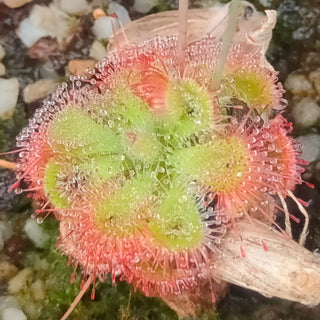Asclepias eriocarpa
WOOLLY POD MILKWEED
- Unit price
- / per
Asclepias eriocarpa is a species of milkweed known by the common names woollypod milkweed, Indian milkweed, and kotolo.
Asclepias eriocarpa is an erect perennial herb which is usually coated in a thick layer of white hairs. The leaves are lance-shaped to oval, rippled, and arranged oppositely in pairs or in whorls of 3 or 4. The inflorescence is a large umbel-like cluster of flowers. Each flower is white to cream and usually tinted with bright pink.
Asclepias eriocarpa is native to California and adjacent parts of Nevada and Baja California, where it grows in many habitat types, especially dry areas.
Type: Hardy perennial
Height: 36-48" (91-122cm)
Location: Sun or part sun
Hardiness zones: 7-10
Seeds per packet: 20
Sow just under the surface of the soil and water in. Temperature 20-22 C (68-72 F) for 4 weeks. They may be growing at this point. If they have not germinated after 4 weeks then a cooling period is required. Cover them with plastic and place in a fridge for 4 weeks. Be sure they stay moist. After the stratification period they are then brought back to room temperature for them to germinate. Germination can be 30-60 days after the warming period, though some can take longer.
Ornamental use only. These seeds and or plants are poisonous.
Asclepias eriocarpa
WOOLLY POD MILKWEED
- Unit price
- / per
Multiple secure payment options available.
Adding product to your cart
You may also like
Asclepias eriocarpa is a species of milkweed known by the common names woollypod milkweed, Indian milkweed, and kotolo.
Asclepias eriocarpa is an erect perennial herb which is usually coated in a thick layer of white hairs. The leaves are lance-shaped to oval, rippled, and arranged oppositely in pairs or in whorls of 3 or 4. The inflorescence is a large umbel-like cluster of flowers. Each flower is white to cream and usually tinted with bright pink.
Asclepias eriocarpa is native to California and adjacent parts of Nevada and Baja California, where it grows in many habitat types, especially dry areas.
Type: Hardy perennial
Height: 36-48" (91-122cm)
Location: Sun or part sun
Hardiness zones: 7-10
Seeds per packet: 20
Sow just under the surface of the soil and water in. Temperature 20-22 C (68-72 F) for 4 weeks. They may be growing at this point. If they have not germinated after 4 weeks then a cooling period is required. Cover them with plastic and place in a fridge for 4 weeks. Be sure they stay moist. After the stratification period they are then brought back to room temperature for them to germinate. Germination can be 30-60 days after the warming period, though some can take longer.
Ornamental use only. These seeds and or plants are poisonous.













































